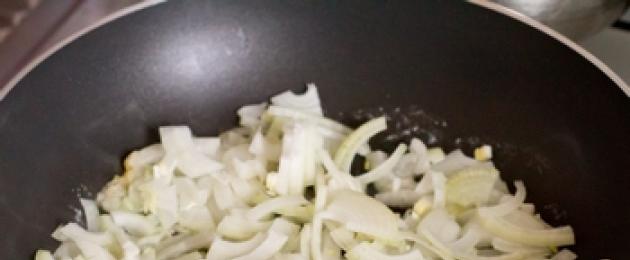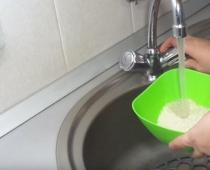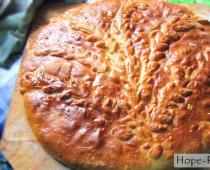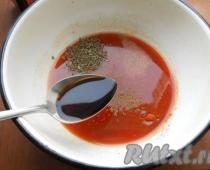is an exquisite dish for true gourmets. A real meat classic. It is obtained from the thickest part of the beef tenderloin, in which there are no fatty layers and connective tissue. The steak is cooked until rare or medium rare, which conveys the extraordinary juiciness of the meat and its creamy taste.
The history of the dish began in the middle of the 19th century, when the personal chef of Viscount Francois-Rene de Chateaubriand prepared for him. The guests of the viscount liked the dish very much, and after a while the Chateaubriand steak got into the menu of expensive French restaurants. Despite the fact that the Chateaubriand steak is a gourmet dish, you can always buy beef tenderloin and cook this delicious cut at home!
In order for the finished Chateaubriand steak to be above all praise, we recommend that you strictly follow the recipe and observe the correct temperature regime. But first things first.
Chateaubriand tenderloin has an oblong cylindrical shape and an impressive thickness. The steaks are cut at least 3 cm thick, so some people have difficulty cooking them.
Advice from T-Bone: when you bought a beef tenderloin, do not rush to cook it right there. Tie it with culinary twine or ordinary thread, securing the original shape, and soak for at least a day in the refrigerator, wrapping it in a clean cotton towel.
There are several ways to cook. You can quickly sear the meat in a skillet, constantly turning it over so that it browns on all sides, and then grill it in the oven. Ready meat can be cut into slices and fry each piece on both sides for 30 seconds. Finished tenderloin slices are poured with sauce and served with a side dish. A good option for those who like medium and medium well roasts.
The classic way to cook a Chateaubriand steak is to pre-fry it in a pan and bring it to the desired degree of readiness in the oven. It is very important to control the internal temperature of the meat. Ideally, it should not exceed 55 degrees.
Advice from T-Bone: meat will acquire new flavors if seasoned with pepper, olive oil, Provence herbs and garlic before frying. But salting the steaks is better at the very end.
Dry- or wet-aged beef does not need to be marinated, tenderized, or hammered. But a simple marinade, in which the meat will lie down for half an hour at most, will not be superfluous.
Classic Chateaubriand steak It will turn out tastier if you marinate it in a spicy paste before frying. It is made from butter, herbs and garlic. Chop all ingredients as small as possible. Place the herbs with garlic in a mortar, season with salt and pepper, and grind well. Then add a little olive oil, stir and rub the bran with the resulting mixture.
Last tip:
Chateaubriand steak is a lean cut and can be easily dried out. To prevent this from happening, cook it over high heat in a well-heated pan. Fry the meat thoroughly on all sides, constantly turning it over. After the steak is fried on all sides, immediately transfer it to a baking dish, cover with foil (it will prevent the meat from burning) and send it to the oven, heated to 220 degrees. Warm up the steak for literally another 3-5 minutes, and then let the meat “rest” without removing the foil.
Chateaubriand is a tender and juicy beef tenderloin steak served with a traditional Béarnaise sauce. Usually one steak is enough for two servings, which makes it a great option for a romantic dinner. For the first time this steak was prepared by the cook of the Viscount de Chateaubriand, which is why it got its name. Since about the middle of the 19th century, the dish has been firmly entrenched in the menu of French restaurants, and then spread throughout the world.
Cooking:
- Prepare the meat: Place the tenderloin on a cutting board for 15-20 minutes to warm and oxygenate the meat.
- To prepare the Béarnaise sauce, place quartered shallots, 4 sprigs of tarragon, vinegar and white wine in a small saucepan.
- Put everything on a small fire. Boil everything until the volume is reduced to 2 tablespoons of golden liquid. Remove from heat and strain through a sieve.
- Melt the butter in a separate bowl or saucepan (it is important to make sure that it does not boil) and leave to cool. Add black pepper, chopped tarragon and parsley (2 sprigs each) to the oil.
- In a separate bowl, beat the egg yolks with a tablespoon of ice water. Put the resulting mixture in a steam bath and beat until foam appears, gradually introducing melted butter.
- Combine both bases and add fresh chopped herbs. Salt to taste.
- Place the steak in a hot and oiled skillet. Fry for 2 minutes on each side until a delicious crust appears - this way you "seal" the juices.
- Then bring the steak to the desired doneness. Medium (10-15 minutes) is considered the best option - in this case, the middle will turn out to be a pleasant pink color. Remove from skillet and sprinkle with freshly ground pepper and salt.
- Serve Chateaubriand steak with sauce and vegetable side dish.
Enjoy your meal!
We clean the cutting from the films. Rub with salt and pepper.
Onion cut into thin half rings. Melt 25 g (1 tbsp) butter in a frying pan or saucepan over medium heat. Add the onion and cook, stirring, until it begins to caramelize, about 10 minutes.


The bow will look something like this:


While the onion is frying, fry the tenderloin in a pan over high heat until golden brown on all sides.
We shift it into a refractory dish and put it in an oven preheated to 180 degrees and bake until the desired degree of readiness. Optimal in this case is medium roast (medium), if you like meat with blood (rare) - let it be with blood
How to determine - below.
It's easiest if you have a meat thermometer:
60 degrees - with blood (rare) - about 10 minutes,
70 degrees - medium rare (medium) - about 15 minutes
80 degrees - fully fried (well done) - 20-25 minutes.
If there is no thermometer, we do everything by hand. Put your thumb and forefinger together on your hand, feel the pad at the base of your thumb - if you touch the roasting meat and feel the same degree of elasticity in the steak - it will be rare. Thumb and middle finger - medium roast (medium - pink meat inside), thumb and ring finger - completely fried (well done).
While the meat comes, bring the sauce to readiness. Pour wine into the onion and reduce the liquid almost completely.


Add broth and reduce by half. Add butter, salt and pepper to taste, stir. Keep the sauce warm.


We take the tenderloin out of the oven, put it on a plate, cover with foil and let it rest for 6-7 minutes. Then cut into slices, pour over the sauce and serve. I had fried green beans with garlic as a side dish.


Enjoy your meal!
Chateaubriand - the king of steak is truly a luxury dish. It is prepared from young beef fillet, usually the middle of the tenderloin is taken.
There are several types of cooking. You can fry the fillet in a piece and then grill it for a short time in the oven. You can fry a piece on all sides, then cut off pieces 4-5 cm wide and fry for an additional 30 seconds on each side. I also saw how they grill in the oven for a while. It is very good to grill on fire. There is a method of frying and then gentle cooking in an oven with a thermometer, where the temperature in the meat core is 55 ° C, it is cooked for 1.5 hours. I'll show you another method.
I like to cook this way because it is quick and easy, and the result is extraordinary. I don't know a better steak. Herbs play a special role here, which I picked optimally to taste. During frying, the herbs partially burn out, creating a smoking effect, and the entire steak is saturated with this smoke. According to the rules for cooking Chateaubriand, the meat can have a color from pink to blood red and, accordingly, from medium to bloody roast. The meat is incredibly juicy, when cut, juice flows out. Served with vegetables of any preparation, green salads and watercress, it is also possible with potatoes, but this is rare. And now let's get started. Good culinary inspiration to all and I look forward to your feedback!
Chateaubriand steak is truly a royal dish. Its juiciness and tenderness is incomparable to any other type of premium beef steaks. It owes its beautiful name to the Vicomte de Chateaubriand, whose chef first prepared this dish. This was a French version of an American tenderloin steak.
For the Chateaubriand steak, a cut of the head of the animal is taken, it is important to note here that the meat of a young bull has the best taste and aroma. In this part of the meat tenderloin, there are practically no fatty inclusions and connective tissues, therefore, with proper preparation, the steak turns out to be the most tender and contains only 267 kcal per 100 grams.

The steak is that part of the tenderloin where the piece of meat becomes an ideal cylindrical shape. From one carcass, you can cook only 2 pieces of Chateaubriand, which are cut strictly perpendicular to the fibers, one serving is enough for 2 people. It is the tenderness and the ability to order one dish for two that makes it the most popular at romantic dinners all over the world.
The classic method of cooking Chateaubriand steaks, known throughout the world, includes several stages and is prepared without the use of seasonings and spices, with the exception of salt and black pepper.
- In order for the fried meat to have its extraordinary softness and not lose its juiciness during cooking, the tenderloin should not be frozen, you need to buy it on the day of use.
- The meat must rest and acquire room temperature, therefore, after rinsing with water and wiping with a napkin, let the future steak lie down for 15-20 minutes.
- Next, generously brush the piece on all sides with olive oil, then rub with a mixture of salt and black pepper.
- It is necessary to heat the pan with oil to 200 degrees and carefully place a piece in it. Then fry on all sides, holding for 60 seconds on each side. In the process of frying, do not spare the oil, it will help in creating that very appetizing crust. It is important not to overexpose the meat on an open fire so that it remains juicy when cut.

A unique possibility of serving a dish: you can bring the steak to the desired degree of roasting:
- reduce the frying process to 10-15 minutes if you prefer a steak with a golden crust and blood inside;
- or cook for 25 minutes if more doneness is required.
The classic recipe does not include the use of herbs and spices, which, with their strong smell, can easily interrupt the exquisitely delicate aroma of a fried steak, so their use is provided for when creating sauces.
What to serve with
For a beautiful presentation and giving an exquisite taste that can emphasize the steak taste of meat, Béarnaise sauce is prepared for Chateaubriand. Béarnaise sauce is a classic French cuisine base sauce with a delicate emulsion texture, made from egg yolks and butter.
Making a sauce requires no less care than a steak. Its emulsion structure can exfoliate at any time, or egg yolks can curdle with intense heating, so you need to cook it carefully.

For its preparation you will need:
- 100 g butter;
- 3 tbsp dry white wine;
- 1 head of shallot;
- 3 tbsp white wine vinegar;
- 3 yolks;
- 3 sprigs of tarragon;
- pepper, salt to taste.
Finely chop the onion and 2 sprigs of tarragon, put in a saucepan. You also need to add salt, freshly ground black pepper, vinegar and white wine. Put the saucepan on the stove and boil the contents over low heat, remove from heat when the future sauce is reduced to about half. Keep an eye on the consistency - the mixture should be quite liquid. Wait until the base of the sauce has cooled and grind it through a sieve.
At this time, you can melt the butter. Next, you need to add egg yolks, lightly beaten with water, and stir until a homogeneous consistency appears. Some recipes allow the use of a blender for this purpose. Put the mixture on a slow fire and pour in the melted butter, previously strained through cheesecloth or non-woven napkin, and heat a little.
The sauce should have a smooth, uniform texture and be slightly fluffy and thick. Gently fold the finely chopped tarragon leaves into the Béarnaise before serving. Serve warm on a plate as an accompaniment, lightly pouring over the rim of the Chateaubriand steak.
If your sauce does separate while adding the butter, just add a few teaspoons of water and mix thoroughly again. Usually, after such a trick, the sauce again acquires the consistency of an emulsion.

In general, if we talk about serving a Chateaubriand steak, other types of sauces are also suitable for it, the main thing is that their taste is rich, and the texture is tender and melting, the same as that of the meat itself. Serving the dish is possible as a whole piece or cut across the fibers on a plate with fresh green vegetables or a mix of salads. As a complementary touch to the royal dish, you can serve a glass of French wine.
Alternative Methods
In addition to the classic way of cooking and serving Chateaubriand steak, it can be cooked in other ways. They may contain spices with pronounced tastes (rosemary, cumin), onions and garlic.
- Fry the steak to the desired degree of doneness and briefly place in the oven for grilling;
- Fry the steak on each side, then cut into pieces 4-5 cm wide and fry again for 30 seconds on each side. This type of cooking allows subsequent grilling in the oven;
- And, of course, the classic for steaks - when the Chateaubriand steak is cooked on fire.
Whatever cooking method you choose, remember that the steak must be done to a certain degree, otherwise you will end up with not Chateaubriand, but a piece of fried meat.
Combining business with pleasure
Getting real pleasure from the pleasant taste of a juicy and tender Chateaubriand steak, do not forget that it has useful properties. This dish is much healthier than hundreds of other kinds of fried and baked meat.
Its use stimulates the processes of metabolism and hematopoiesis, helps to strengthen muscle and bone tissues, has an antioxidant, anti-inflammatory, immunostimulating effect.
- In contact with 0
- Google Plus 0
- OK 0
- Facebook 0







